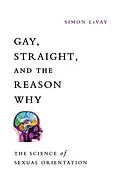What causes a child to grow up gay or straight? In this book, neuroscientist Simon LeVay summarizes a wealth of scientific evidence that points to one inescapable conclusion: Sexual orientation results primarily from an interaction between genes, sex hormones, and the cells of the developing body and brain. LeVay helped create this field in 1991 with a much-publicized study in Science, where he reported on a difference in the brain structure between gay and straight men. Since then, an entire scientific discipline has sprung up around the quest for a biological explanation of sexual orientation. In this book, LeVay provides a clear explanation of where the science stands today, taking the reader on a whirlwind tour of laboratories that specialize in genetics, endocrinology, neuroscience, cognitive psychology, evolutionary psychology, and family demographics. He describes, for instance, how researchers have manipulated the sex hormone levels of animals during development, causing them to mate preferentially with animals of their own gender. LeVay also reports on the prevalence of homosexual behavior among wild animals, ranging from Graylag geese to the Bonobo chimpanzee. Although many details remain unresolved, the general conclusion is quite clear: A person's sexual orientation arises in large part from biological processes that are already underway before birth. LeVay also makes it clear that these lines of research have a lot of potential because--far from seeking to discover "what went wrong" in the lives of gay people, attempting to develop "cures" for homosexuality, or returning to traditional explanations that center on parent-child relationships, various forms of "training," or early sexual experiences--our modern scientists are increasingly seeing sexual variety as something to be valued, celebrated, and welcomed into society.
Autorentext
Simon LeVay is a British-born neuroscientist who has served on the faculties of Harvard Medical School and the Salk Institute for Biological Studies. He has written ten previous books, including the New York Times best-seller, When Science Goes Wrong.
Inhalt
Introduction Chapter 1: What Is Sexual Orientation? Criteria for sexual orientation Sexual orientation in men and women Stability of sexual orientation Prevalence of different orientations Are there categories? Sexual orientation across cultures Chapter 2: Why We Need Biology Psychoanalytic theories Learning theories-influence of early sexual experiences Learning theories-gender learning Is it a choice? The biological alternative Chapter 3: The Outline of a Theory 30 Male and female brains Male and female behaviors Development of sex differences in animals Sexual partner preference in animals Origins of variation within each sex Relevance to human sexual orientation Sexual orientation in nature Chapter 4: Childhood Development of gendered childhood traits Childhood traits associated with adult sexual orientation: retrospective studies Prospective studies Contrasting models Chapter 5: Characteristics of gay and straight adults Gendered traits in adulthood 54 Origin of gendered traits Sexual orientation and cognitive traits: visuospatial abilities 58 Verbal fluency Memory tasks Handedness Intelligence Personality traits: Masculinity-femininity Occupational preferences Other personality traits Sexuality Overview Chapter 6: The role of sex hormones Hormone levels in gay and straight adults Why focus on prenatal sex hormones? Hormone levels during development Congenital adrenal hyperplasia Finger length studies The inner ear Central auditory system Action of sex hormones on the developing brain Possible causes of variability in prenatal androgen levels Chapter 7: The role of genes Sibling studies Is the family clustering caused by genes? Twin studies Molecular genetics-candidate-gene studies Genome scans Genes and sexuality in fruit flies Genes, homosexuality, and evolution Kin selection The "fertile female" hypothesis Beneficial effects on same-sex relatives Chapter 8: The brain A brief tour of the brain The hypothalamus and sexual orientation Other brain regions Brain activity Pheromone studies Sheep Overview Inhibition and sexual orientation Chapter 9: The body Body size and shape Trunk and limb length Penis size Symmetry and developmental instability Hair whorl direction Gaydar Overview Chapter 10: The older-brother effect How well established is the older brother effect? How strong is the older brother effect? The older-brother effect and handedness What causes the older-brother effect? Is the older-brother effect adaptive? Chapter 11: Conclusions Sexual orientation is linked to other gendered traits A common origin for gender-shifted traits? The role of genes Does the older-brother effect work through prenatal hormones? Is there a random biological influence? How does sexual orientation become categorical? Diversity among gay people Changes in the prevalence and nature of homosexuality Sexual orientation and gender: the social fallout Glossary Bibliography
